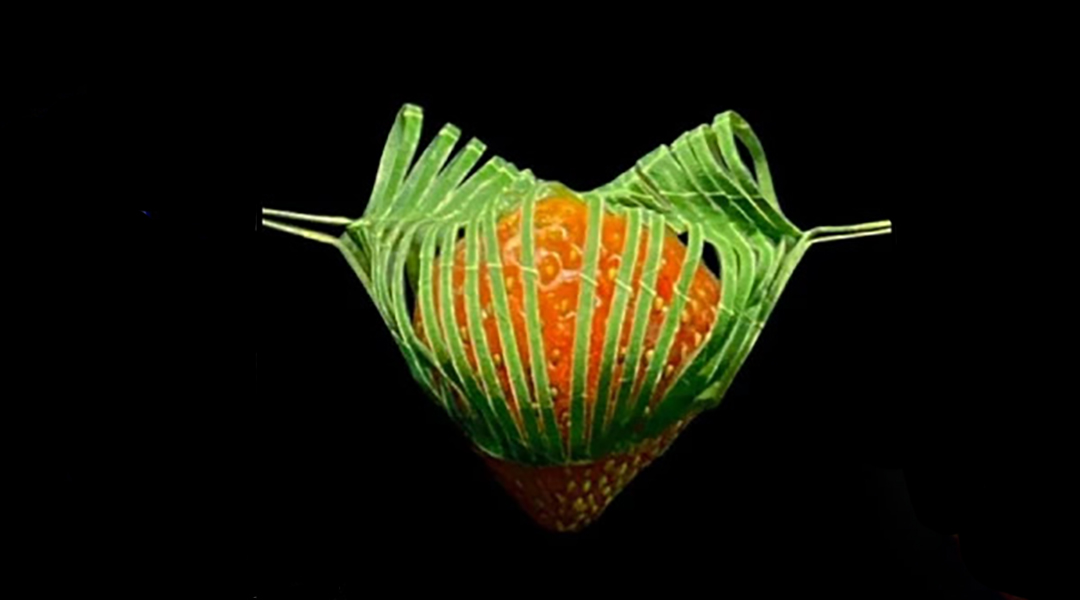Using your hands, you can easily pick up a grape without squashing it and then lift a crate of wine without causing injury. This strength and subtlety is hard to replicate in artificial devices, which typically trade off strength, delicacy, and precision to function only within a limited range of weight or size.
But a new lightweight gripper, inspired by the Japanese paper cutting art of kirigami, is both gentle and strong, precise enough to pick up microfibers 40 times thinner than a human hair, and tough enough to lift objects 16,000 times its own weight.
The versatile gripper, which can be made of a variety of materials, could be useful everywhere from hospitals to the deep sea. It could be used to augment prosthetic limbs, handle biological waste, or collect soft-bodied sea creatures, bringing an ancient art form to the cutting edge.
Modern interpretation of an ancient art form
Kirigami is a traditional art form that involves cutting and folding paper to create intricate designs – from the Japanese words for ‘cut’ and ‘paper’, whereas origami stems from “fold” and “paper”.
A team from the Department of Mechanical and Aerospace Engineering at North Carolina State University applied this concept to the creation of the gripper, slicing precise lines through a flat material to create a ribbed structure that can expand and contract. Because the gripper’s properties are largely derived from its structure rather than the material it is made from, it can be made from a range of materials, including a leaf.
“In practical terms, this means that you could fabricate the grippers out of biodegradable materials, such as sturdy plant leaves,” explained Yaoye Hong, co-author of the paper and a recent Ph.D. graduate from NC State. “That could be particularly useful for applications where you would only want to use the grippers for a limited period of time, such as when handling food or biomedical materials. For example, we’ve demonstrated that the grippers can be used to handle sharp medical waste, such as needles.”
Soft but strong
The team’s design is delicate enough to pick up a single drop of liquid and tough enough to life a 6.4kg weight. This combination of capabilities is unique and stems from the way force is distributed throughout the structure of the gripper. The load of a heavy object is spread across the strands so no one section strains and breaks, and this balance of force also allows a gentle cupping of fragile or unstable objects.
“It is difficult to develop a single, soft gripper that is capable of handling ultrasoft, ultrathin, and heavy objects, due to tradeoffs between strength, precision and gentleness,” said lead author and associate professor of mechanical and aerospace engineering Jie Yin. “Our design achieves an excellent balance of these characteristics.”
Engineers around the world are working on grippers of all shapes and sizes. This is the team’s second iteration of a kirigami-inspired gripper, this time building on previous designs to improve its performance. When compared to the wider field, the latest design stands up well.
“The strength of robotic grippers is generally measured in payload-to-weight ratio,” Yin said. “Our grippers weigh 0.4 grams and can lift up to 6.4 kilograms. That’s a payload-to-weight ratio of about 16,000. That is 2.5 times higher than the previous record for payload-to-weight ratio, which was 6,400. Combined with its characteristics of gentleness and precision, the strength of the grippers suggests a wide variety of applications.”
Many grippers are built with a particular use in mind, ultimately forcing designers to sacrifice one property for another. A gripper in a car factory may favor stable strength over subtlety, but a paper-folding machine might rely on precise pinpoint movement. This gripper design aims for versatility, and being useful in a wide range of situations raises the possibility that it might make a real difference to people’s lives.
Where will they be used?
To test the gripper, the team integrated it with first a robotic arm and then into a muscle-controlled prosthetic limb. Unlike a factory robot arm, human prostheses might turn a page in one moment, then pull open a heavy door in another. Many conventional prostheses struggle to achieve both of these tasks, and the precise and delicate tasks that make up the minutiae of daily life, like pulling a zipper or picking up a sweet, are particularly difficult. When implemented within a prosthetic arm, the gripper lent a new subtlety of touch.
“The new gripper can’t replace all of the functions of existing prosthetic hands, but it could be used to supplement those other functions,” said co-author Helen Huang, professor in the Joint Department of Biomedical Engineering at NC State and the University of North Carolina at Chapel Hill. “And one of the advantages of the kirigami grippers is that you would not need to replace or augment the existing motors used in robotic prosthetics. You could simply make use of the existing motor when utilizing the grippers.”
“We think the gripper design has potential applications in fields ranging from robotic prosthetics and food processing to pharmaceutical and electronics manufacturing,” Yin said. “We are looking forward to working with industry partners to find ways to put the technology to use.”
As the team continues to refine the design, they hope to bring even more applications into the fold, cutting through to make real impact and grasping the many opportunities it presents.
Reference: Jie Yin, et al., Angle-programmed tendril-like trajectories enable a multifunctional gripper with ultradelicacy, ultrastrength, and ultraprecision, Nature Communications (2023). DOI: 10.1038/s41467-023-39741-6
Feature image credit: Hong, Y., Zhao, Y., Berman, J. et al., Nat Commun 14, 4625 (2023). https://doi.org/10.1038/s41467-023-39741-6, CCBY 4.0

















